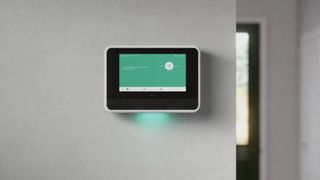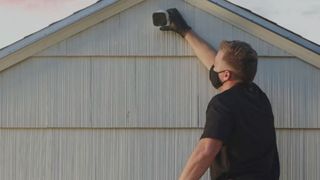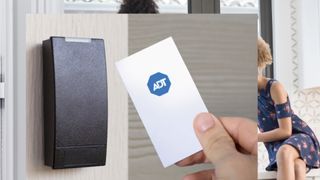ADT vs Vivint – what's the best business security?
We compare Vivint and ADT from a business POV, with overviews of pricing, sensors and surveillance, cybersecurity, and more

ADT and Vivint are two of the biggest names in security, and both made our list of the best security systems for businesses available today. Security systems like ADT and Vivint help businesses monitor locations for break-ins, fire or flood, employee safety, and more. In this article, we compare ADT vs Vivint from a professional point of view, focusing on the factors businesses will care about most.
ADT is a veteran of the security domain, but recently expanded its business offering with ADT Commercial. The sheer range of physical and cybersecurity solutions, including advanced access control, is impressive. Vivint also offers custom systems for businesses, albeit much simpler ones which are particularly well-suited to small businesses with a single location.
Keep reading to learn more about each security system and which use cases each is best suited to.
What we compared
There’s more to security systems than just sensors and cameras. We also look at the ease of setup and use, pricing, and a variety of features that will help businesses make the most of each system.
- Setup and user interface
- Pricing
- Sensors and video surveillance
- Access Control
- Automations
- Cybersecurity
Setup and user interface
With both ADT and Vivint, installation of your system will be performed by a specialist. The cost and duration of installation will vary depending on the components you’ve chosen for your business and the number of locations you have, but you can estimate around 2 to 4 hours per location. In both cases, once the hardware installation is complete, everything is managed from a single iOS or Android app.

Both apps enjoy high ratings from Android and iOS users, although ADT comes out slightly ahead with an average rating of 4.8 (ADT) compared to 4.5 (Vivint). In each case, the app enables you to arm and disarm your entire system or single points, adjust lighting and temperature, control door locks, and see the health of your devices.
For larger businesses, though, ADT’s eSuite account management dashboard allows you to monitor multiple locations and gain insights into activity, like the number of break-ins, dispatches, fires and hold-ups over a given period. The suite integrates with ADT’s access control systems and security systems, and boasts 2-factor authentication, user groups, location management and keypad code management. ADT is a clear winner here for larger businesses.
Pricing
As far as hardware is concerned, solutions for both ADT and Vivint are offered on a per-quote basis. You’ll need to reach out to each company for a personalized quote based on your business’s needs.
ADT plans and pricing
| Header Cell - Column 0 | ADT Secure | ADT Interactive | ADT Complete |
|---|---|---|---|
| Price | Contact for quote | Contact for quote | Contact for quote |
| Intrusion detection + hold-up alarm monitoring | ✓ | ✓ | ✓ |
| Temperature + flood monitoring | ✓ | ✓ | ✓ |
| Event history | Row 3 - Cell 1 | ✓ | ✓ |
| Alerts + notifications | Row 4 - Cell 1 | ✓ | ✓ |
| Custom scheduling | Row 5 - Cell 1 | ✓ | ✓ |
| Remote access, arm + disarm | Row 6 - Cell 1 | ✓ | ✓ |
| Climate + lighting control | Row 7 - Cell 1 | ✓ | ✓ |
| Small appliance management | Row 8 - Cell 1 | ✓ | ✓ |
Vivint plans and pricing
| Header Cell - Column 0 | Smart Security | Smart Monitoring | Smart Video Monitoring |
|---|---|---|---|
| Price | $29.99 a month | $39.99 a month | $44.99 a month |
| Mobile access | ✓ | ✓ | ✓ |
| Entry, smoke + CO detection | ✓ | ✓ | ✓ |
| Medical pendant support | ✓ | ✓ | ✓ |
| Professional 24/7 monitoring | ✓ | ✓ | ✓ |
| Smart home integration | Row 5 - Cell 1 | ✓ | ✓ |
| Video surveillance | Row 6 - Cell 1 | Row 6 - Cell 2 | ✓ |
It’s worth noting that ADT has a particularly long contract length, starting at 36 months. Vivint, on the other hand, offers month-by-month pricing. In both cases, you’ll need the most expensive package to get video surveillance, arguably one of the most important elements for a business.
Sensors and video surveillance
Both Vivint and ADT offer a variety of sensors and video cameras for surveillance.
Both companies offer cameras with 1080p HD video recording and live streaming, plus night vision for dark or low-light conditions. You can also find cameras with two-way intercoms and floodlights. In this regard, the offer is quite similar.

Likewise, both Vivint and ADT offer door and window sensors and motion sensors, with wired and wireless options. ADT’s motion sensors cover a slightly smaller area (35’ x 40’) than Vivint’s (40’ x 50’), which means that more ADT sensors would need to be installed to cover the same surface area.
Vivint and ADT also both offer carbon monoxide, water and leak, smoke, and temperature sensors. However, with its Commercial offering, ADT also supports electronic article surveillance (security tags on clothing, alcohol, etc.), skin temperature monitoring (to reduce the spread of disease), and occupancy management. Many of these services are actually provided by third parties, but ADT will coordinate everything seamlessly so you only have to deal with ADT itself.
Access control
Most businesses need to both monitor and control who has access to stock and storage, archives, offices, and more. Vivint offers door locks with a touchscreen panel that can be controlled by smartphone, tablet/computer, and keyfob. Up to 30 unique keypad codes can be assigned, and you can also customize codes for specific days and times.

ADT pulls ahead here by offering everything Vivint does, plus keycard readers and intercoms designed for business use. ADT also offers visitor management, allowing you to identify and log individuals entering protected areas. ADT Commercial also offers vaults and locks, bulletproof glass, hold-up and duress buttons, and cash processing equipment.
Automations
Vivint offers some automations, mostly designed for home use. However, these will also work well in a small business setting. Vivint users can set up automatic lighting, door locking (and unlocking during a crisis), and temperature control.
However, once again, ADT’s business and commercial offer here is far more extensive. Like Vivint, ATD offers automated climate and lighting controls, but adds smart plugs for turning off appliances and devices remotely.
Cybersecurity
If you’re looking for an all-in-one solution for security and cybersecurity, ADT is probably better suited to your needs. ADT offers managed (third-party) cybersecurity solutions with firewall (including installation), content filtering, weekly reports, and add-on products like email security and VPN services. Vivint does not offer digital services.
Of course, businesses can also keep these services separate. There are many excellent VPNs for businesses and antivirus software with built-in firewall protection available for business today. However, it can be simpler for IT departments to deal with just one provider like ADT, especially if the’yre also responsible for the technology supporting your business’s physical security.
Which security service is best for me?
Smaller businesses will find the straightforward solutions offered by Vivint attractive in both their simplicity and pricing. These solutions will be sufficient for small offices and commercial or retail spaces, with easy setup, monitoring, and an intuitive app.
However, larger companies will benefit greatly from ADT’s bespoke business and commercial solutions, which boast better access control, cybersecurity, and automations.
| Header Cell - Column 0 | Vivint | ADT |
|---|---|---|
| Setup and interface | Simple and straightforward | Greater complexity for large businesses |
| Pricing | Starting at $36.99 a month | Starting at $29.99 a month |
| Sensors and video surveillance | Wide range of sensors and cameras | Wide range of sensors and cameras |
| Access control | Basic smart locks | Extensive access control solutions |
| Automations | Lighting, locking, and temp control | Lighting, locking, temp control, and integrations |
| Cybersecurity | None | Firewall, monitoring and VPN |
What our reviewers said
Vivint
“Although Vivint is first and foremost a home security provider, the options for businesses are great. The ability to deploy an army of sensors on every window and door could be a big selling point for business owners with large premises. This, coupled with the ease of the Vivint Smart Hub, really simplifies the job of monitoring security.”
- Score: 4.5/5
Read our full Vivint review.
ADT
“ADT is probably best for businesses who have specialized security needs like access control or EAS, or those who want the most comprehensive custom-built system and service… like those needed by pharmacies, automotive businesses, and retail.”
- Score: 4/5
Read our full ADT review.
Alternatives to ADT and Vivint
Businesses have a few options for security systems. SimpliSafe is one great alternative for small businesses, with pre-built kits, no contracts, and phone support all starting at $10 a month.
Vivint allows customers to pay for infrastructure over a longer period of time, but at just $489 for SimpliSafe’s Haven plan with four door sensors and temperature and smoke sensors, most businesses will be fine paying Simplisafe’s costs upfront.
For businesses keen on a DIY solution, Frontpoint was our top pick. Its plans are straightforward, if a little pricier than competitors’, but you save on professional installation. You can also build your own plan with components that fit your budget.
Again, ADT will be better for enterprises, but small businesses and storefronts will enjoy the flexibility with Frontpoint.
More on business security
Proper business security doesn’t stop with surveillance and intrusion detection. Cybersecurity is equally important. Choose from among the best password managers for businesses to control access to information among employees and boost security with stronger passwords across users. The best business VPNs can provide an extra layer of security, too.
Get the ITPro. daily newsletter
Receive our latest news, industry updates, featured resources and more. Sign up today to receive our FREE report on AI cyber crime & security - newly updated for 2024.
Christian is a freelance writer and content project manager, with over six years' experience writing and leading teams in finance and technology for some of the world's largest online publishers, including TechRadar and Tom's Guide.





